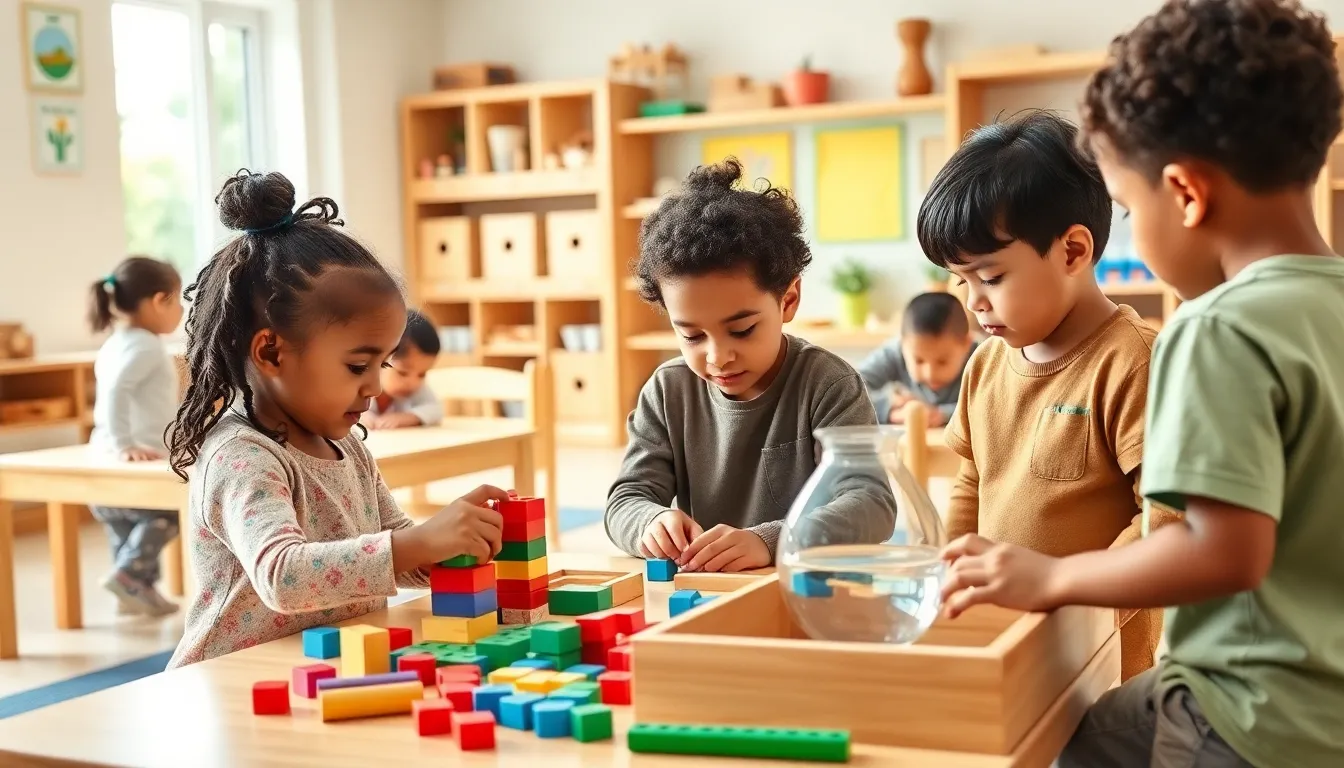Table of Contents
ToggleWhen it comes to education, the battle lines are drawn. On one side, you have the Montessori method, where kids learn at their own pace, exploring the world like tiny, curious scientists. On the other, there’s the traditional approach, with structured lessons and a “sit down and pay attention” mantra that could make even the most enthusiastic learner yawn.
Parents often find themselves in a dilemma: should they unleash their child’s inner explorer or stick to the tried-and-true methods? Both styles have their merits, but understanding their differences can feel like trying to solve a Rubik’s Cube blindfolded. In this article, we’ll dive into the quirks and perks of Montessori and traditional education, helping parents make an informed choice while keeping the laughter flowing. After all, who said learning can’t be fun?
Overview of Montessori Vs Traditional Education
Montessori education encourages child-led exploration and learning. This approach allows children to choose activities based on their interests. Students engage with materials at their own pace, fostering independence and intrinsic motivation. In contrast, traditional education follows a structured curriculum and set schedules. Teachers often direct classroom activities and guide student learning through lectures and standardized methods.
Montessori classrooms promote mixed-age groups, enabling peer learning. Younger students benefit from observing older peers, while older students reinforce their understanding by teaching concepts to others. Traditional education typically groups students by age, creating a competitive environment focused on grades and performance. This structure can inadvertently limit collaboration and social interaction among students.
In Montessori settings, assessment revolves around individual progress, emphasizing mastery of concepts rather than competition. Teachers provide ongoing feedback tailored to each child’s development. Traditional education relies on standardized testing to gauge achievement, which may overlook individual learning styles and strengths.
Materials in Montessori environments are often hands-on and designed to enhance sensory experiences. Children manipulate physical objects to discover concepts in a tangible way. Traditional education usually employs textbooks and worksheets that emphasize rote memorization and passive learning. This could lead to disengagement if students do not see the real-world application of their studies.
Both methods aim to foster a love of learning, yet they do so through vastly different frameworks. Montessori’s focus on collaboration and self-discovery contrasts sharply with traditional education’s emphasis on compliance and structured assessments. Understanding these distinctions aids parents in making informed choices about their children’s education.
Key Principles of Montessori Education

Montessori education centers around key principles that differentiate it from traditional methods. This approach emphasizes respect for each child’s unique learning pace and style.
Child-Centered Learning
Child-centered learning prioritizes individual interests and exploration. In Montessori settings, children select activities that capture their attention, promoting intrinsic motivation. Teachers guide rather than dictate, allowing learners to pursue their passions. Freedom within a structured environment encourages autonomy. This personalized approach fosters creativity and critical thinking skills, which standard approaches often overlook. Assessment focuses on personal growth, enabling children to advance at their own speed.
Mixed Age Classrooms
Mixed age classrooms enhance social interaction and collaboration. Children of varying ages learn alongside each other, promoting peer learning and mentorship. Younger students observe and emulate older peers, building confidence and skills. Older students reinforce their learning by teaching concepts, which solidifies their understanding. This dynamic creates a cooperative atmosphere rather than a competitive one, common in traditional grade-based classrooms. In such environments, students develop social skills and emotional intelligence, preparing them for real-world interactions.
Key Principles of Traditional Education
Traditional education emphasizes a structured approach, focusing on teacher-directed learning. Educators lead classes through lectures, ensuring a clear transmission of core knowledge. This method often utilizes textbooks and standardized curricula to cover essential topics. Students typically follow a set schedule, engaging in lessons that align with predetermined learning objectives.
Teacher-Directed Instruction
In teacher-directed instruction, the teacher plays a central role in the learning process. They deliver content through straightforward presentations, reinforcing concepts with examples. Assessments often measure students’ understanding based on uniform criteria. Direct instruction allows teachers to maintain control over classroom dynamics, which some argue promotes discipline and order. This approach fosters an environment where students receive consistent guidance but may limit opportunities for independent exploration.
Age-Specific Classrooms
Age-specific classrooms group students according to their chronological age, creating a uniform learning environment. Educators design lessons tailored to the average developmental stage of that age group. This method supports peer interactions among similar-aged learners, fostering social bonds. However, this can also lead to competition for grades and accolades, which some educators find detrimental to collaborative learning. Overall, traditional education’s focus on age-specific groupings shapes the social experience within the classroom.
Comparison of Learning Environments
Montessori and traditional education present distinct classroom setups and learning materials, impacting student experiences.
Classroom Setup
Montessori classrooms feature open spaces filled with learning stations. These environments encourage free movement, allowing children to choose activities that match their interests. Flexibility in seating arrangements fosters collaboration among mixed-age groups, promoting peer learning. In contrast, traditional classrooms often follow a structured design with rows of desks facing the teacher. Such layouts focus on individual work and teacher-centered instruction, creating a competitive atmosphere. Age-specific groupings in traditional education facilitate social interactions but limit exposure to diverse age perspectives. Ultimately, the setups in these learning environments significantly influence how students engage and connect with the material and their peers.
Learning Materials
Montessori emphasizes hands-on learning through specially designed materials that stimulate exploration and discovery. These materials encourage sensory experiences, allowing children to grasp concepts by interacting with them. Examples include geometric shapes and tactile resources that promote understanding of abstract ideas. Traditional education typically relies on textbooks, worksheets, and digital tools that emphasize rote memorization. While these materials provide structure, they may not cater to individual learning styles. Montessori materials support self-directed exploration, fostering curiosity. In contrast, traditional resources often standardize learning experiences, potentially hindering creativity. Selecting appropriate materials plays a crucial role in shaping how students perceive and interact with their educational journeys.
Impact on Child Development
Montessori and traditional education significantly impact child development with differing methods.
Social Skills
Montessori environments encourage cooperative play and collaborative learning, promoting strong social skills. Children learn to communicate effectively with peers, as they often work in mixed-age groups. Peer interactions foster empathy, negotiation, and conflict resolution, essential skills for social competence. In contrast, traditional education typically emphasizes competition and individual achievement. Students often focus on grades within age-specific classrooms, limiting opportunities for developing social abilities. Group work is often secondary to lectures and standardized tests. While traditional education provides structured interactions, Montessori methods create rich social environments that enhance relationships among children.
Academic Performance
Academic performance in Montessori settings reflects mastery of subjects through self-paced learning. Children engage with hands-on activities, deepening their understanding and retention of concepts. Mastery combines with intrinsic motivation, leading to sustained academic interest. Traditional education often prioritizes test scores and uniform assessments. Rote memorization and standardized curricula dominate, sometimes causing disengagement. The focus on grades can overshadow actual learning, limiting personal academic growth. Research indicates that Montessori students often outperform their traditional peers in various subjects over time. Montessori approaches emphasize critical thinking and problem-solving, nurturing well-rounded learners equipped for future challenges.
Choosing between Montessori and traditional education involves understanding the unique benefits and challenges each approach presents. Montessori’s emphasis on individualized learning and collaboration can cultivate a child’s natural curiosity and social skills. In contrast, traditional education’s structured environment provides clear guidance and consistency, which some children may thrive under.
Parents should consider their child’s personality and learning style when making this decision. Ultimately, both methods offer valuable pathways to foster a love for learning. By recognizing the core differences between these two educational philosophies, parents can make informed choices that best support their child’s development and educational journey.





